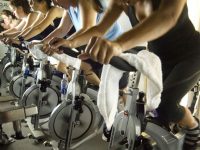In part 1 of this series on high resistance/low cadence riding, I described a friend on a mountain bike ride who was mashing his pedals in his big gear up the first part of a long climb simply because he “wanted a leg workout,” only to suffer later in the ride, almost to the point of not being able to finish. His ego prevented him from seeing the wisdom of my advice that he shouldn’t push that hard, pedaling that slow so early in the ride.
Your students, however, aren’t going to be faced with a longer, more challenging segment after your 50- or 60-minute class, like my humiliated friend in my mountain biking story. When the class is over, it’s over. They can cheat indoors without too much consequence if they don’t get injured…if you cheat outdoors, the consequences are potentially more grave, like getting injured or not being able to continue while stuck way out in the woods with another 20 miles to get back home. Because they don’t fear the consequences, they may be resistant to your wise advice when you tell them they shouldn’t pedal with that much resistance.
It’s important to educate these riders that they are placing themselves at substantial physical risk. Pedaling with so much resistance that cadence drops down below 50 rpm has no functional value to anything they do, not to cycling, not to any other sport or exercise, and certainly, not to anything else in life.
When performing an exercise or drill, we want that exercise to be relevant to what we do in life, either in our favorite sport or in our activities of daily life. This is referred to as “functional training.” Our bodies gain fitness in a very specific way; in exercise science, we call it the specificity principle. There is nothing functional or specific about pedaling at a cadence this slow with such a high resistance. And it’s not going to make you “stronger.”
To clarify this point, let’s discuss how we gain strength.


Great information. Thank you Jennifer. We definitely ride to the beat in my classes (60 rpm +) and even though one of them is a drop-in, I don’t see the heavy R pedalers, but I occasionally sub a very popular early morning class where more than a few participants mash pedals for much of the class. I encourage a higher cadence approach and I think that is all I can do as the group loves their usual high R instructor.
Thank you so much for the information! It is good to know the specifics and I am always wanting to make sure that there is correct form.
If I am pedaling heavy then, I shouldn’t feel a “strain” in my low back? Also, is it wise to engage the abs while climbing?